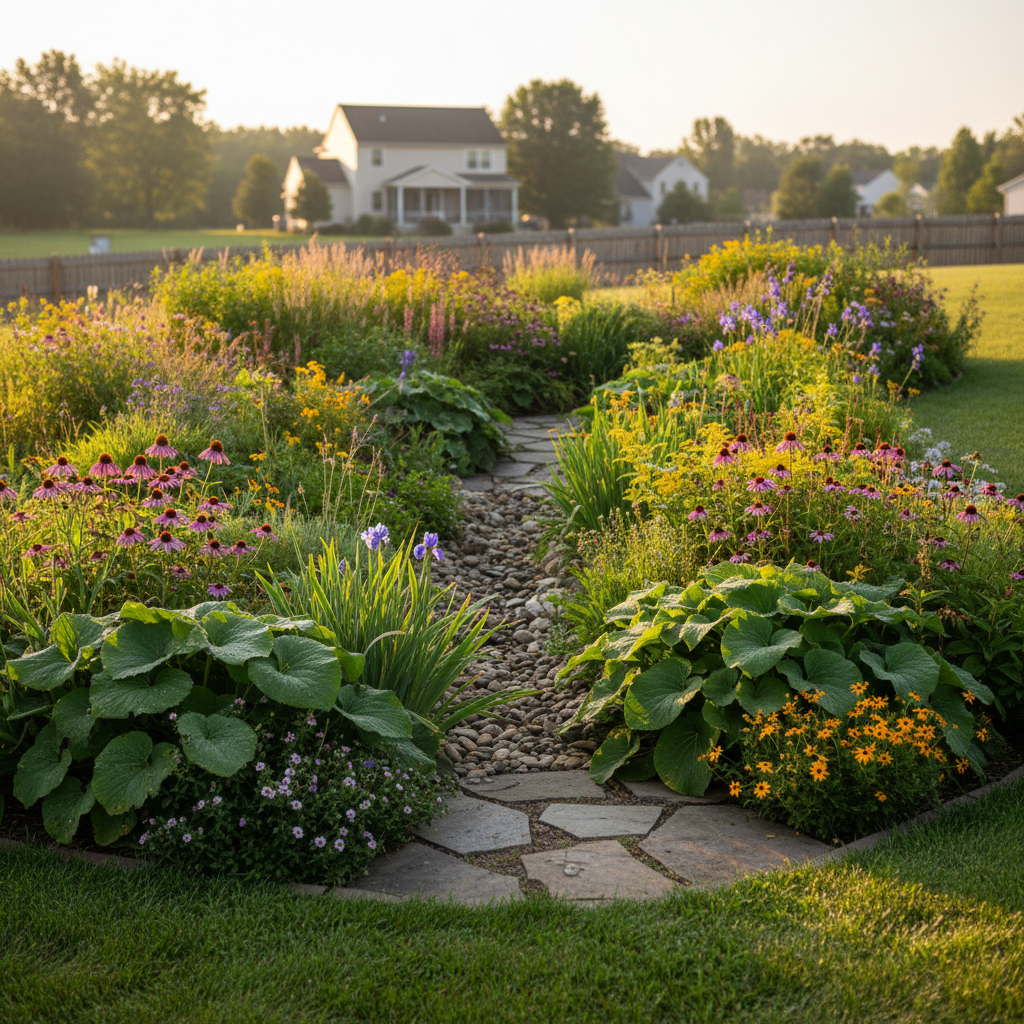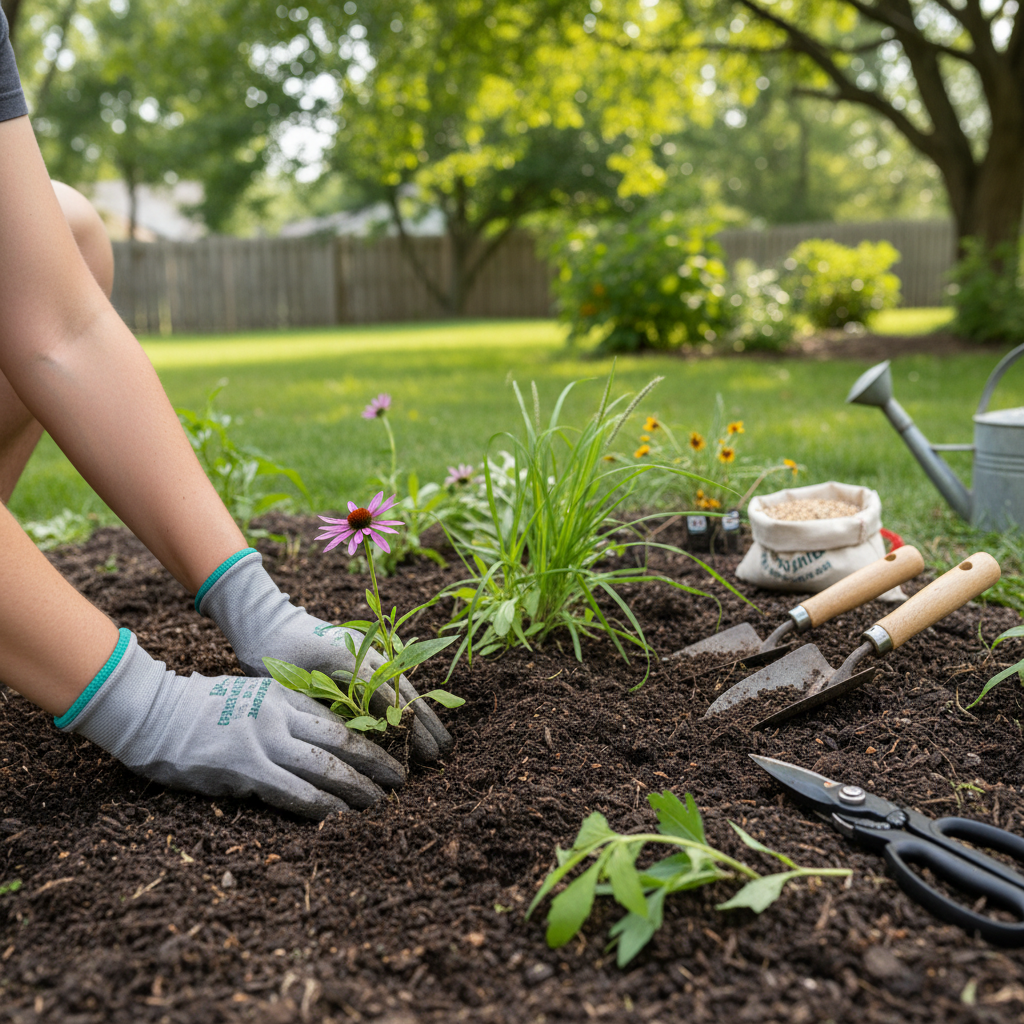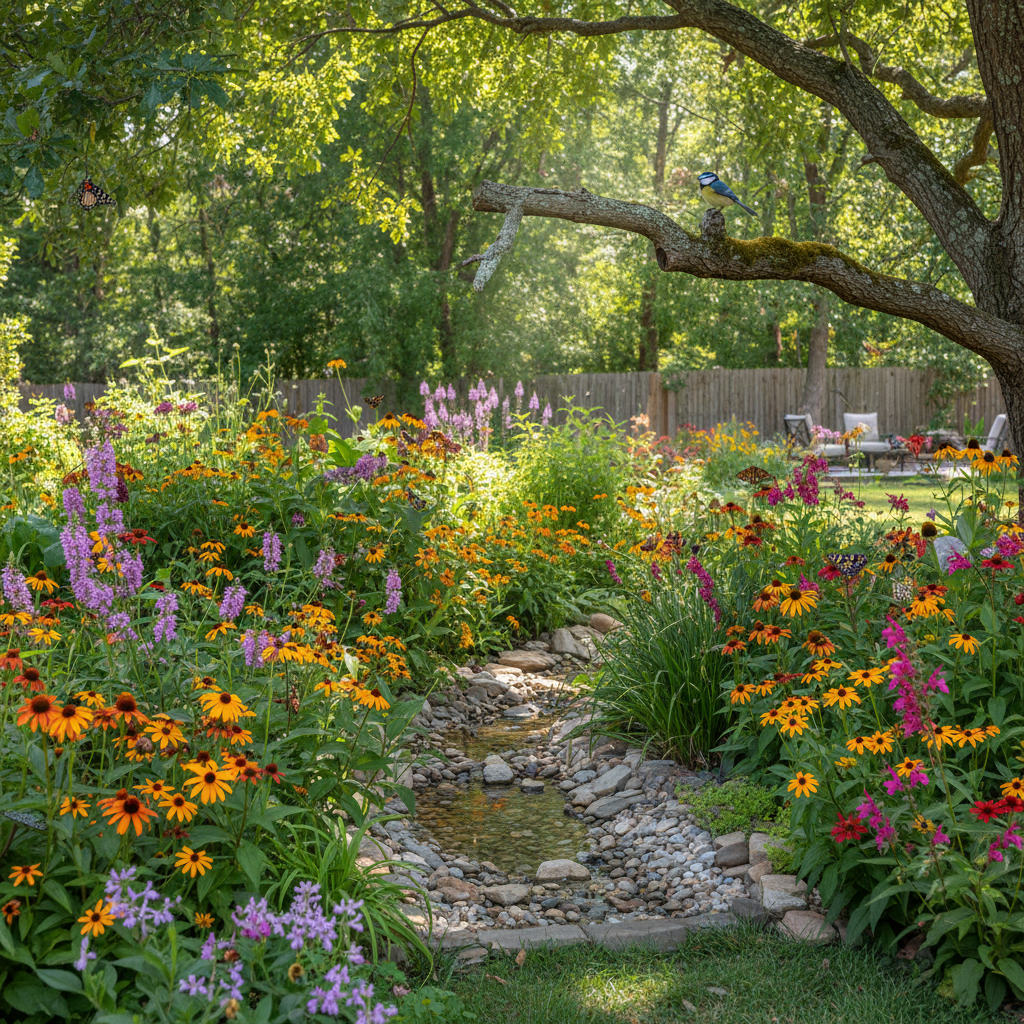
Table of Contents
Introduction
Imagine transforming a simple patch of land into a vibrant ecosystem that not only beautifies your outdoor space but also plays a crucial role in managing stormwater naturally. This is the power of a rain garden—a purposeful, carefully designed garden that helps capture and filter rainwater runoff, protecting the environment and enhancing your home’s landscape. Whether you’re an avid gardener, a sustainability enthusiast, or someone looking to make a positive environmental impact, building a rain garden offers a rewarding and practical solution to common urban water challenges.
Rain gardens have emerged as an effective green infrastructure method to address stormwater issues caused by impervious surfaces like roofs, driveways, and sidewalks. These surfaces prevent rainwater from soaking into the ground, leading to excess runoff that can overwhelm storm drains, contribute to flooding, and carry pollutants into nearby water bodies. By capturing this runoff, rain gardens reduce water pollution and runoff volume, helping to maintain healthier local waterways and ecosystems. In fact, studies have shown that a well-designed rain garden can absorb up to 30% more water than a traditional lawn area, significantly alleviating drainage problems in urban and suburban settings.
Beyond their environmental function, rain gardens also foster biodiversity by providing habitat for native plants, pollinators like bees and butterflies, and other wildlife. This contribution to local ecology aligns with the growing movement toward sustainable, eco-friendly living. For homeowners concerned about the rising impact of climate change and extreme weather, installing a rain garden is a proactive step toward resilience and environmental stewardship. It also enhances property aesthetics with lush, colorful vegetation that changes through the seasons, offering year-round visual interest.
However, building a rain garden requires planning, the right choice of plants, understanding your soil type, and a clear construction process to ensure it functions effectively. Addressing these factors can be daunting without guidance, which is why this step-by-step guide aims to provide all the essential information you need. From selecting the right location to digging the basin and choosing native plants suited for wet and dry cycles, each stage is covered with clear instructions and expert advice.
What You’ll Learn in This Guide
In this comprehensive guide, you’ll discover everything necessary to design, build, and maintain a rain garden tailored to your landscape and climate. Here’s what to expect:
- Understanding Rain Gardens: Learn what a rain garden is, why it’s important for managing stormwater, and how it benefits the environment and your community. This foundation sets the stage for informed decision-making.
- Planning and Design: Explore key design considerations, including choosing the right size, shape, and location based on your property’s runoff patterns and landscape features. Tips for selecting proper tools and materials are included to prepare you for construction.
- Site Selection and Soil Preparation: Gain insights into evaluating soil drainage and permeability to ensure your rain garden will absorb water effectively. Discover methods to improve soil quality to support healthy plant growth, ensuring long-term success.
- Plant Selection and Construction Steps: Understand how to select native and adaptive plants that thrive in your rain garden’s wet and dry conditions. Follow detailed step-by-step instructions for excavation, shaping, planting, and mulching to build a functional and attractive rain garden.
With these areas covered, you’ll be equipped with practical knowledge and confidence to embark on your rain garden project successfully and sustainably.
As we delve deeper into the details, this guide will also highlight important maintenance practices to keep your rain garden thriving year after year. We will explore seasonal care routines and troubleshooting common challenges that may arise. Additionally, you’ll learn about the broader environmental benefits, from enhancing groundwater recharge to supporting local biodiversity and reducing urban heat effects.
By implementing the step-by-step recommendations here, you can transform your outdoor space into a vital, eco-friendly oasis that improves water quality, mitigates flooding risks, and creates a habitat for wildlife. The value extends beyond aesthetics to meaningful environmental impact and cost savings on stormwater management.
Ready to get started? Let’s begin by understanding the foundational principles behind rain gardens and how they function in your landscape. This knowledge will prepare you to make smart choices as we proceed through site evaluation, planning, and construction. Your journey to sustainable living and a healthier environment starts here—with one rain garden at a time.

Building on the introduction to rain gardens, it is essential to delve deeper into the practical aspects of creating one that functions effectively and sustainably. A rain garden is more than just a beautiful landscaping feature; it plays a critical role in managing stormwater runoff, reducing pollution, and enhancing local biodiversity. Understanding the detailed planning, site preparation, and construction processes empowers homeowners and environmental enthusiasts to contribute positively to their surroundings. As we explore the key stages of building a rain garden, this comprehensive discussion will provide insights supported by practical tips and expert knowledge to guide you step-by-step on the journey to a thriving rain garden.
Planning and Design Considerations for Your Rain Garden
Planning and designing a rain garden begins with thoughtful consideration of your landscape’s specific characteristics and the goals you want to achieve. An effective rain garden must be carefully tailored to intercept and absorb stormwater runoff without causing issues like flooding or soil erosion. It’s crucial to assess the amount of runoff expected, the garden’s size and shape, and placement in relation to existing landscape features. By taking these factors into account early, you ensure that your rain garden will not only function properly but also complement your outdoor space aesthetically.
Designing a rain garden involves choosing appropriate dimensions and location based on the watershed area contributing to runoff. The garden should be positioned to capture water flowing from impervious surfaces such as roofs and driveways. Also, consider the slope, existing vegetation, and soil conditions of your site. For example, a garden on a gentle slope can allow better water infiltration, whereas steeper areas might require terracing or retaining walls. Collaboration with or reference to local experts or guidelines can be extremely beneficial during this process.
Key Elements in Rain Garden Design
When designing your rain garden, paying attention to several critical elements can greatly influence its success and sustainability. Below are important components to consider:
- Shape and Size: The shape of your rain garden is often dictated by topography and space availability. Common shapes include oval, crescent, or kidney-shaped gardens, which facilitate natural water flow and maximize infiltration. Size should correspond to the volume of runoff you need to manage, typically between 10-30% of the impervious surface area draining into it.
- Site Location: Choosing a site that receives runoff but is not too close to your home foundation or septic system is important for safety and structural integrity. A minimum distance of 10 feet is generally recommended to prevent water-related damage.
- Water Flow Management: Plan for an inlet and outlet to manage excess water flow during heavy rains. Inlets help direct runoff into the garden, while outlets allow overflow to exit without causing erosion.
- Plant Selection and Placement: Incorporate native plants that tolerate both wet and dry conditions and arrange them based on their water needs and height. Plants placed in the center can handle more water, while those on the edges prefer drier soil.
Site Selection and Soil Preparation for Optimum Rain Garden Performance
The foundation of a functional rain garden lies in choosing the right site and preparing the soil to maximize water absorption and plant health. Site selection involves evaluating soil types, slope, sun exposure, and existing drainage patterns to ensure your rain garden can effectively capture and filter stormwater. Testing soil permeability will help determine if any amendments are needed for optimal drainage.
Proper soil preparation not only increases water retention capacity but also supports diverse plant growth. Sometimes, native soils may be compacted or have poor infiltration rates, which can hinder the garden’s effectiveness. In such cases, soil amendment, including the addition of organic matter or sand, can significantly improve permeability and nutrient availability.
Steps for Soil Testing and Improvement
For the best results, consider the following steps regarding soil preparation:
- Soil Permeability Test: Conduct a simple percolation test by digging a hole and filling it with water to observe drainage time. A drainage rate of 0.5 to 1 inch per hour is ideal for rain gardens, ensuring water doesn’t pond too long or drain too quickly.
- Soil Amendment: Based on test results, amend your soil by mixing in compost or sand to improve structure. Compost adds organic matter to help retain moisture and nutrients, while sand improves drainage in heavy clay soils.
- Grading and Excavation: Grade the site to create a shallow basin that directs water inward. Excavate to the appropriate depth — usually 6 to 12 inches — to accommodate both soil amendments and plant roots.
- Mulching and Stabilization: Apply mulch after planting to protect soil, retain moisture, and reduce weed growth. Mulch also prevents soil erosion during runoff events and gradually breaks down to enrich soil quality.

Conclusion
Building a rain garden is not only a beautiful way to enhance your outdoor space but also a highly effective method to manage stormwater naturally, reduce runoff, and improve local water quality. Throughout this guide, you have learned the critical importance of planning carefully—from selecting the right site with proper slope and drainage to testing and amending soil to support plant health and water absorption. Your rain garden serves as a living system, capturing stormwater and filtering pollutants before they reach waterways, helping to protect aquatic ecosystems and reduce pollution. Beyond this environmental impact, rain gardens foster local biodiversity, attracting native pollinators, birds, and beneficial insects that support a thriving backyard ecosystem. This combination of practical function and ecological benefit makes rain gardens a vital part of sustainable landscaping practices.
Understanding the specific needs of your garden’s location, including choosing native plants suited to both wet and dry conditions, ensures the garden will thrive year-round. You’ve also explored the detailed steps involved in construction, from excavation and shaping to planting and mulching, all designed to optimize water retention and soil health. Ongoing maintenance, such as watering during dry spells, weeding, and seasonal care, is essential to keep your garden healthy and functional over time. By paying attention to these details, your rain garden will become a resilient and dynamic feature that adapts naturally with seasonal changes and heavy rain events. Watching the garden mature and seeing how it successfully captures runoff while supporting wildlife offers a rewarding experience that connects you directly with nature’s cycles.
With this knowledge in hand, you are well-equipped to begin your rain garden project confidently. Start by observing your property’s natural runoff paths and selecting a location that balances functionality and aesthetic appeal. Test your soil, amend as needed, and carefully plan the size and shape of your basin to handle expected rainwater volumes. Consider native plant species that are adapted to your region’s climate and soil conditions, arranging them by water tolerance to create a balanced ecosystem. Follow the construction steps with care, and don’t forget to mulch to conserve moisture and prevent weeds. Regular maintenance will protect your investment and ensure long-term success. This hands-on process not only benefits your home environment but also contributes positively to your neighborhood and local waterways.
Building a rain garden is a powerful step toward greener living and environmental stewardship. It transforms a simple patch of land into a multifunctional landscape feature that manages stormwater, reduces flooding risks, improves water quality, and supports wildlife habitat. Most importantly, it empowers you as a homeowner and community member to make a tangible difference. Whether you’re new to gardening or an experienced green enthusiast, creating a rain garden is an achievable and fulfilling project that brings beauty, sustainability, and ecological awareness to your doorstep. Embrace this opportunity to care for your environment and enjoy the lasting rewards of a thriving, healthy rain garden.
